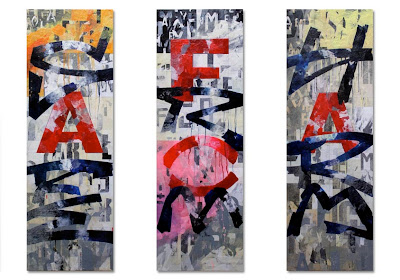Many of my paintings employ
a fairly vivid palette these days.
However, there is a variety of utilitarian battleship grey that also
seems to recur in my work, providing a useful foil to the passages of heightened
colour. There’s nothing clever
about it, it’s usually just a mixture of Titanium White and Mars Black about halfway along the tonal scale between the two extremes.
 |
| 'Safe From Harm 1', Acrylics & Paper Collage on Three Panels, Each Panel: 150cm X 50cm, 2011 |
For all my love of colour, I
always return to that unassuming grey for its ability to give the eye a brief
rest within a painting and allow a neutral space where simultaneous contrasts
may occur optically. Perhaps, in
the not too distant future, I’ll attempt a primarily grey painting. Indeed, Gerhard Richter practically
made a career of that at one time or another.
 |
| Gerhard Richter, 'Stadtbild M8 (Grau)', ('Townscape M8 (Grey)', Oil on Canvas, 1968 |
 |
| Gerhard Richter, 'Grau' ('Grey'), Oil on Canvas, 1968 |
Another painter who, I think, uses grey beautifully is Christopher Wool. I originally came to Wool through his stark, ironic text paintings but also love his more recent wiped abstracts. The greys in these canvases are the result of the turpsy dilution of black paint rather than of methodical mixing and are full of beautiful nuance and transparent tonality. I think there are parallels between his looping, self-cancelling calligraphic lines and the graffiti tags which always catch my attention.
 |
| Christopher Wool, 'Untitled', Enamel on Linen, 2009 |
 |
| Christopher Wool, 'Untitled', Enamel on Linen, 2007 |
Out in the field, I particularly associatiate the colour with
industrial surface coatings of a mundane, practical nature. A while back I realised this probably
originates in my observation and photographic documentation of the most
unassuming forms of street furniture, - the grey boxes. I’ve been collecting these
for a while now as I travel around with my camera and have even been known to
return to a specific site that I’ve observed from the car window on a routine
trip. Pointing my camera at them
always attracts bemused stares from passers by, making me realise just how eccentric the activities I take for granted as an artist must seem to
some folk.
I don’t even really know
what purpose they serve, although it’s pretty obvious that they generally
contain electrical equipment. As
many sit at junctions or kerbsides, I assume they contain the control systems
for traffic signals or street lighting.
Possibly, some are part of telecommunications networks.
At first glance the boxes
appear pretty similar but closer acquaintance reveals that they’re all actually
individual in different ways. Of
course, what really distinguishes them, and the reason they first came to my
attention, is the wealth of graffiti, fly posters, stickers and other examples
of unofficial signifiers they attract.
It’s evident that many constitute way-markers in the network of taggers’
territorial squirtings; whilst others become regular bulletin boards for fly
posters and accrue beautiful textures of torn paper, tape residue and text fragments in the
process.
These photographs were all
taken in Leicester and Birmingham and are collected in a round-up of the ‘interesting grey boxes’ I’ve found over recent months, (this
bit makes more sense if you imagine it spoken in an adenoidal, anoraky voice).











No comments:
Post a Comment